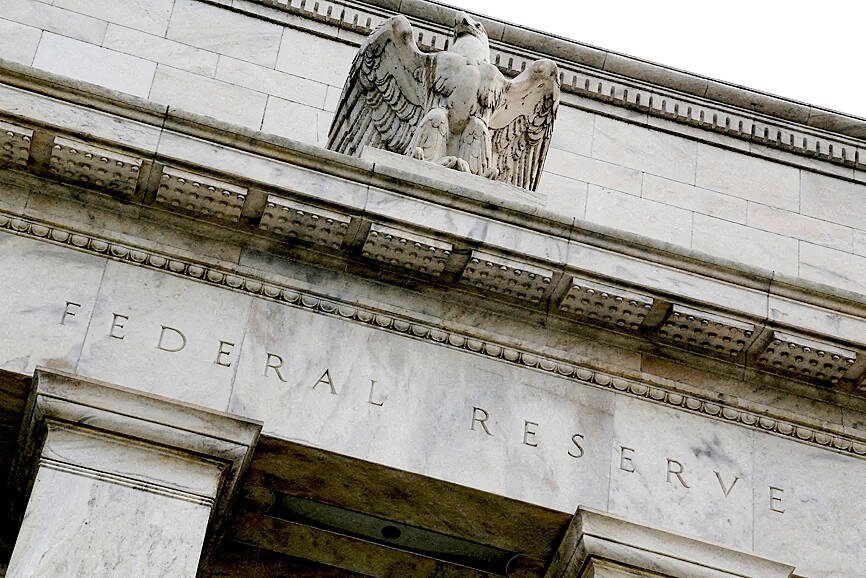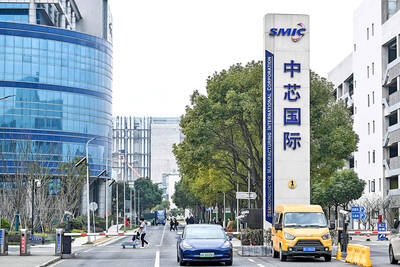The US Federal Reserve is widely expected to keep interest rates unchanged at its policy meeting this week, treading carefully amid uncertainty over US President Donald Trump’s economic policies, which include spending cuts and sweeping tariffs.
Since January, Trump has imposed levies on major trading partners Canada, Mexico and China, and on steel and aluminum imports, roiling financial markets and fanning fears that his plans could tip the world’s biggest economy into a recession.
The Trump administration has also embarked on unprecedented cost-cutting efforts that target staff and spending, while the US president has promised tax reductions and deregulation down the road.

Photo: Reuters
However, Fed Chairman Jerome Powell emphasized this month that it is the “net effect” of policy changes that would matter for the economy and monetary policy.
Analysts widely expect the central bank to hold the benchmark lending rate steady at 4.25 percent to 4.50 percent, after similarly doing so in January.
“Recent Fed commentary has reinforced a wait-and-see approach, with officials signaling little urgency to adjust policy as they assess the economic impact of recent policy shifts,” Ernst & Young chief economist Gregory Daco said.
Powell himself has said that policymakers are focused on separating signal from noise as the outlook evolves.
“We do not need to be in a hurry, and we are well positioned to wait for greater clarity,” Powell said in a recent speech in New York.
Oxford Economics Ltd economist Michael Pearce said he expects the Fed would not want to “overreact” to early signs that inflation might pick up, or to indications that the economy is weakening more quickly than anticipated.
The Fed has previously kept rates elevated to tamp down inflation. Cutting rates, conversely, typically stimulates economic activity, providing a boost to growth.
“It’s a bit of a dilemma for the Fed,” as there could be conflicting signals, Pearce said.
ING Groep NV analysts expect the Fed to signal its base case remains two 25 basis point cuts this year, adding that “there is no pressing need for additional rate cuts given that unemployment is low and inflation is still tracking hot.”
US government data last month showed that the unemployment rate was a relatively low 4.1 percent, with the labor market remaining stable. Meanwhile, the consumer price index came in at 2.8 percent for last month as well, cooler than expected, but still some distance from officials’ 2 percent target.
This boosts expectations that the Fed would proceed cautiously, as it seeks to lower inflation sustainably.
Inflation is “likely to remain above target through the rest of the year given the impetus from tariffs,” ING analysts said.
They said in a recent note that the use of levies could “escalate significantly,” as Trump seeks to bring manufacturing back to US shores, potentially triggering price hikes.
The US economy is strong enough to weather a downturn from tariffs, meaning the Fed would unlikely be forced to respond to weakening conditions, Pearce said.
However, there remains a risk that more weakness comes through and that the Fed “will react to a growth scare and loosen policy sooner,” he said.
Powell “will have to tap dance around policy uncertainty and its cousin market volatility” in a news conference after the Fed’s rate decision is announced on Wednesday, Daco said.
Private sector activity is slowing as policy uncertainty remains elevated, while stocks have pulled back notably, he said.
GDP growth is also likely to stall in the first quarter, in part due to weaker consumer spending.
“Powell may find it difficult to reaffirm that the economy is ‘holding up just fine,’ and that it ‘doesn’t need us to do anything,’” Daco added in a note.
The Fed’s policy stance could shift rapidly with economic conditions, he said.
“A reactionary monetary policy stance means policy direction could rapidly turn more dovish on weaker economic and labor market data, just like it could turn hawkish with hotter inflation readings,” he said.

NO BREAKTHROUGH? More substantial ‘deliverables,’ such as tariff reductions, would likely be saved for a meeting between Trump and Xi later this year, a trade expert said China launched two probes targeting the US semiconductor sector on Saturday ahead of talks between the two nations in Spain this week on trade, national security and the ownership of social media platform TikTok. China’s Ministry of Commerce announced an anti-dumping investigation into certain analog integrated circuits (ICs) imported from the US. The investigation is to target some commodity interface ICs and gate driver ICs, which are commonly made by US companies such as Texas Instruments Inc and ON Semiconductor Corp. The ministry also announced an anti-discrimination probe into US measures against China’s chip sector. US measures such as export curbs and tariffs

The US on Friday penalized two Chinese firms that acquired US chipmaking equipment for China’s top chipmaker, Semiconductor Manufacturing International Corp (SMIC, 中芯國際), including them among 32 entities that were added to the US Department of Commerce’s restricted trade list, a US government posting showed. Twenty-three of the 32 are in China. GMC Semiconductor Technology (Wuxi) Co (吉姆西半導體科技) and Jicun Semiconductor Technology (Shanghai) Co (吉存半導體科技) were placed on the list, formally known as the Entity List, for acquiring equipment for SMIC Northern Integrated Circuit Manufacturing (Beijing) Corp (中芯北方積體電路) and Semiconductor Manufacturing International (Beijing) Corp (中芯北京), the US Federal Register posting said. The

India’s ban of online money-based games could drive addicts to unregulated apps and offshore platforms that pose new financial and social risks, fantasy-sports gaming experts say. Indian Prime Minister Narendra Modi’s government banned real-money online games late last month, citing financial losses and addiction, leading to a shutdown of many apps offering paid fantasy cricket, rummy and poker games. “Many will move to offshore platforms, because of the addictive nature — they will find alternate means to get that dopamine hit,” said Viren Hemrajani, a Mumbai-based fantasy cricket analyst. “It [also] leads to fraud and scams, because everything is now

MORTGAGE WORRIES: About 34% of respondents to a survey said they would approach multiple lenders to pay for a home, while 29.2% said they would ask family for help New housing projects in Taiwan’s six special municipalities, as well as Hsinchu city and county, are projected to total NT$710.65 billion (US$23.61 billion) in the upcoming fall sales season, a record 30 percent decrease from a year earlier, as tighter mortgage rules prompt developers to pull back, property listing platform 591.com (591新建案) said yesterday. The number of projects has also fallen to 312, a more than 20 percent decrease year-on-year, underscoring weakening sentiment and momentum amid lingering policy and financing headwinds. New Taipei City and Taoyuan bucked the downturn in project value, while Taipei, Hsinchu city and county, Taichung, Tainan and Kaohsiung